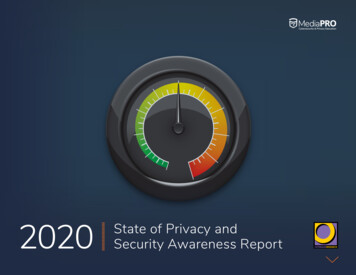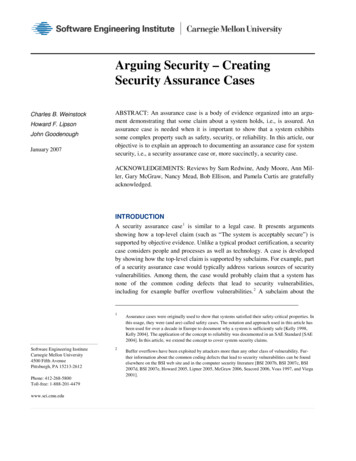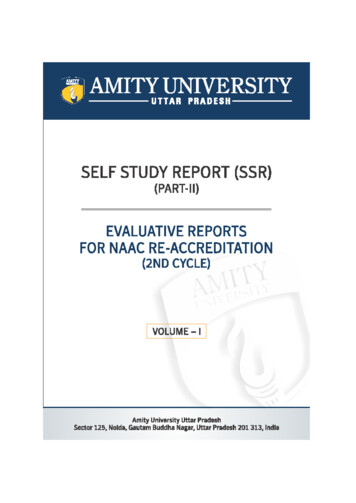
Transcription
2020State of Privacy andSecurity Awareness Report
EXECUTIVESUMMARYOsterman Research conducteda survey on behalf of MediaPROduring October 2019. The goal of thisresearch was to determine the levelof awareness about cybersecurityand privacy best practices amongemployees in a wide variety oforganizations serving variousindustries in the United States. Wewanted to determine not only whatemployees know (or don’t know)about these best practices, but alsothe extent to which they put theirknowledge into action.About This ReportThis report was produced via apartnership between Osterman Researchand MediaPRO. MediaPRO sponsoredOsterman Research to design and conductthe survey, collect responses, and producea written report based on analysis of theresults. MediaPRO managed the layout anddesign of the report.Key TakeawaysMore efforts are needed in security awareness trainingWe discovered that many employees are unaware of several key risk factors as theyrelate to cybersecurity and privacy. For example, more than two in five employeesdo not think that clicking a suspicious link or opening a suspicious attachment in anemail is likely to lead to a malware infection.Some employees are misinformed about cybersecurity risksMany employees think it’s safe to plug unknown USB sticks into their workcomputer, most think there is little risk in leaving unencrypted data on their laptopor mobile device, and many believe that they should respond to the sender of asuspected social engineering attack to determine if the attack is real.Many employees don’t believe that cybersecurity is theirpersonal responsibilityWhile many users are well-informed about key cybersecurity issues like malwarerisks, how to create strong passwords, and the necessity of upgrading software,many will not report security incidents, nor do they consider it their responsibility totake additional security safeguards within their corporate systems.Privacy best practices seem to be less well understood thancybersecurity best practicesMost employees do not know whether or not their organization needs to complywith a variety of key privacy regulations and guidelines, such as the EuropeanUnion’s General Data Protection Regulation (GDPR), the California Consumer PrivacyAct (CCPA), or the Payment Card Industry Data Security Standard (PCI DSS).MediaPRO.com 425-483-4700 2
Section 1:Awareness of Key Issues Is Lacking (Page 4)A large proportion of employees self-report that they cannot perform a variety of key tasksthat would enable them to protect their organizations from various cyberthreats.Section 2:Some Users Are Misinformed About Cybersecurity Risks (Page 6)Employees reported “knowing” a variety of things about cybersecurity, but many of thesethings simply aren’t accurate.TABLE OFCONTENTSSection 3:Most Users Are Somewhat Informed (Page 8)Though some topic areas showed room for improvement, respondents proved relativelyknowledgeable in password knowledge, physical security, and other areas.Section 4:More Engagement in Overall Cybersecurity Process Is Needed (Page 11)Results suggest employees could be more engaged in their company’s cybersecurityposture, especially when it comes to incident reporting and addressing sensitiveinformation discussed in the open.Section 5:Common Privacy Regulations Are Not Well Understood (Page 13)Many employees lack confidence in their understanding of privacy regulations, conveyingprivacy guidelines, and taking steps to protect data.Section 6:Many Users Are Aware of Good Privacy Practices (Page 15)Despite a relative lack of knowledge about privacy regulations, we found a generalunderstand that the consequences of privacy breaches could be severe.Section 7:Mapping Responses Across Multiple Risk Areas (Page 17)When mapped across the 17 different risk areas we asked questions around, more than 50%of the employees we surveyed fall onto the “risky” side of the spectrum in terms oftheir reported practices and attitudes.Section 8:Conclusion: There’s Still Work to Do (Page 20)Section 9:About the Survey (Page 21)Section 10:About MediaPRO and Osterman Research (Page 24)MediaPRO.com 425-483-4700 3
Awareness of Key Issues Is LackingCybersecurity Knowledge Could Use Improvements2020 STATE OF PRIVACY AND SECURITY AWARENESS REPORTA large proportion of employees self-report that they cannot perform a variety of key tasks that would enable them to protect their organizationsfrom various cyberthreats. For example: One in five employees were unsure if they could describe to theirsenior management the security risks created by storing workinformation in personal cloud applications, while only 22% saidthey’d be very confident doing so. Only 17% of employees are “very confident” that they can identifya “social engineering attack,” while more than one-quarter ofemployees (28%) admitted a lack of confidence in identifying aphishing email. Only 27% can identify at least two warning signs that malware hasinfected their computing platform.A summary of the confidence that employees have (or typically don’t have) about key cybersecurity best practices is shown in Figure 1.FIGURE 1:Employee Confidence About Key Cybersecurity Best PracticesVeryConfidentConfidentNot SureSomewhatConfidentNot at allConfidentYour current set of passwords is both strong and has not beenpreviously compromised39%37%11%10%3%Identifying a phishing email37%35%12%12%4%Identifying at least two warning signs that malware has infected yourdesktop/laptop computer or mobile device27%34%17%15%7%Describing the steps needed to actively secure work information andresources while working remotely27%35%17%13%8%Describing to your senior management the negative impacts to yourorganization posed by cybersecurity risks25%33%18%13%11%Describing to your senior management the security risks created bystoring work information in personal cloud applications22%34%20%12%13%Describing to your senior management the security risks created byemployees working from home22%33%19%15%12%Describing to your senior management how security expectations forprivileged users differ from those for standard users21%30%24%11%13%Identifying a social engineering attack17%25%33%12%14%IssueSource: Osterman Research, Inc.MediaPRO.com 425-483-4700 4
Many Employees Are Not Aware of Some Key Risk FactorsOur research also discovered that many employees lack awareness of a variety of key risk factors that could lead to data breaches, ransomware orother malware infections, or other security threats. For example:2020 STATE OF PRIVACY AND SECURITY AWARENESS REPORT 43% of employees are not aware that clicking a suspicious link oropening an unknown attachment in an email is likely to lead to amalware infection. One-quarter (25%) of employees believe it’s acceptable to use apersonal cloud server to transfer work home so as long as theircloud service performs a virus scan before downloading any files. More than one-half of employees (55%) are not convinced thatconnecting their laptop, smartphone or tablet to a public Wi-Finetwork, such as in a coffee shop or an airport, is likely to lead to amalware infection.Why Is This Important?Employee awareness of cybersecurity and privacy issues is an essential element of any organization’s cybersecurity posture. Thebetter informed that employees are about key issues, the more likely they are to be better able to defend against social engineeringand other attacks. It’s that simple. Awareness is the critical first step to enabling employees to become a valuable defensive layer oftheir organization’s security posture.However, our research found that awareness of some seemingly basic cybersecurity threats and best practices —let alone puttingthis awareness into action—is lacking among many employees. For example, more than one-quarter of employees admittedthey’d struggle identifying a phishing email, two in five cannot describe to their senior management the negative impacts posed bycybersecurity risks, and three in five cannot identity a social engineering attack.Our research strongly suggests many organizations are putting themselves at risk from potentially devastating incidents by ignoringthe benefits of security awareness training.MediaPRO.com 425-483-4700 5
Some Users Are Misinformed About Cybersecurity RisksOne of the more interesting set of findings from the research is that employees “know” a variety of things about cybersecurity, but many of these2020 STATE OF PRIVACY AND SECURITY AWARENESS REPORTthings simply aren’t accurate, as shown in Figure 2. Let’s dive deeper into these findings.Proximity does not lead to infectionOur research found that one in seven employees (14%) believe thatif their computer or mobile device is kept too close to a device that isalready infected with malware, their device could also become infectedwith the same malware.Leaving computers unlocked does not lead tomalware infectionLeaving computers unlocked while they are unattended is a badidea because unauthorized users could gain access to sensitiveor confidential data. However, 39% of employees mistakenlybelieve that leaving their computer unlocked can also result ina malware infection.FIGURE 2:Employee Perceptions About the Likelihood that Computers or MobileDevices Could Become Infected with Malware as a Result of Various %0%Clicking a suspiciouslink or attachment inan emailSource: Osterman Research, Inc.Using weak/simplepasswordsUsing the samepassword for multipleapplicationsConnecting to a publicWi-Fi network, e.g.,in an airport orcoffee shopLeaving your computerunlocked while awayBeing too close to otherdevices that are alreadyinfected with malwareMediaPRO.com 425-483-4700 6
Many don’t believe that checking the “To:” fieldis necessary2020 STATE OF PRIVACY AND SECURITY AWARENESS REPORTThe “type-ahead” feature in many email clients, such as MicrosoftOutlook, provides a convenient shortcut for users when sending anemail. However, it also creates a security risk by enabling users tomore easily send an email to the wrong party.For example, typing the first few letters of the intended recipient’sfirst name into the “To:” field in an email might bring up a numberof potential recipients, and many users will hit the return key on thewrong recipient.While it’s a best practice to always check that the right recipientsare specified in the “To:” field, we found that 20% of those surveyeddisagree or are unsure if they would.Responding to social engineering attacks is not agood ideaA cybercriminal who steals a user’s login credentials and takes overan email account can then use that account to send phishing andother types of social engineering attacks. This poses a huge problemfor recipients of these malicious emails because they look genuineand are, in fact, are coming from a valid email account.The one thing that recipients of these social engineering attacksshould never do after receiving such an email is to respond back tothe sender asking for clarification or more information. However,39% of those we surveyed disagree—they think that replying back tothe sender is a good idea.What about random USB drives?Should you plug just any USB drive into your computer? The answeris a resounding “No,” because cybercriminals use this technique toinstall malware into targeted networks or computers. But peopleseem to do it anyway.For example, a study by researchers at the University of Illinois in2016 found that 48% of 297 USB sticks dropped around the campuswere picked up and plugged into various computers.Our own research found that 14% of employees believe it’s safe toplug random USB drives into their work computer.Unencrypted data is not risk freeWe also found that 51% of those surveyed believe there is relativelylittle risk in having unencrypted data on their laptop or mobile device,despite the fact that this is one of the primary methods by which databreaches occur.Authenticating mobile devices is key32% of employees believe that not securing their laptop or mobiledevice with a password represents little to no security risk.Why Is This Important?Awareness of what constitutes a cyberthreat is key for employees, but the inverse is also true. Misinformation is another enemy of astrong cybersecurity posture.Our research found that many employees have perceptions about cybersecurity that just aren’t true: many believe that simply beingin physical proximity to a malware-infected computer or mobile device, or leaving a computer unlocked while away, can lead to amalware infection. A key element of a good security awareness training program is helping employees to distinguish cybersecurityfact from fiction.MediaPRO.com 425-483-4700 7
Most Users Are Somewhat InformedDespite the findings discussed in the previous section indicating that employees are not as well-versed in cybersecurity as they perhaps should be,2020 STATE OF PRIVACY AND SECURITY AWARENESS REPORTthere were some encouraging findings about the current state of employees’ cyber know-how:Most know how to identify a malware infectionChanging the home router’s default passwordThe majority of employees seem to be well-versed in identifyingthe telltale signs of a malware infection: 58% of the employees wesurveyed correctly identified “popups rapidly interrupting otherprograms” as the most likely indicator that their desktop or laptopcomputer has become infected with malware.Routers come with default passwords that are often quite easyto guess, and so these should be changed when the router isconfigured.Most are reasonably password-savvyOur research found that the majority of employees have at least someknowledge about password best practices.For example, we found that 52% of employees know it’s important touse a unique password for every device and application; 37% considerit important to always include a special character (e.g., , , & or *) intheir password; and 91% consider the password “D0nt5top&elie n” tobe either “strong” or “very strong.”Software upgrades are keyWe found that 61% of employees agree or strongly agree thatwhen working from home they should change their router’s defaultpassword before accessing corporate data or email.Most can identify ways to maintain physical securityWhile cybersecurity threats pose significant risks to any organization,so do physical risks, such as letting unbadged individuals throughsecure doors or leaving confidential documents in plain view on adesk.We found that 69% of employees are confident or very confident thatthey can identify at least four ways to keep work areas and resourcessafe from various physical security threats.The vast majority of employees (84%) understand that theyshould install software upgrades in order to help protect againstcybersecurity threats.Employees’ views on various cybersecurity issues are shown in Figure 3 (page 9).1https://www.vice.com/en om 425-483-4700 8
FIGURE 3:Agreement with Various Statements About Cybersecurity Issues2020 STATE OF PRIVACY AND SECURITY AWARENESS REPORTStronglyAgreeAgreeNot SureDisagreeStronglyDisagreeWhenever I send important company data through our secure email system,I should always double-check the “To:” field to ensure that each recipient isauthorized to view the data45%34%16%3%1%I should install software upgrades to protect my devices from cybersecuritythreats44%40%11%3%1%If I work from home, I should change my router’s default password beforeaccessing corporate data or email27%34%32%7%1%A coworker’s credentials mistakenly give them access to corporate systems.You mention it to them and they seem honestly confused and don’t seemto be using their access with malicious intent. Nevertheless, they should beconsidered an insider threat16%44%29%9%1%If I delete a phishing email without clicking on or opening anything it meansthat I’m completely safe15%27%27%26%5%When I receive a strange request through email which might be a socialengineering attempt, it’s a good idea to reply with a new email to verify therequest before taking any action15%24%22%19%21%I’m a privileged user, but I don’t work in IT. That means that I have a responsibility to perform my job duties carefully, but that’s it. It’s not appropriate forme to take additional safeguards within our systems11%23%21%28%17%We have important documents on our company’s cloud server, but I save aworking copy on my local computer instead of struggling with the cloud service’s live editing feature. As long as I upload my copy, things will stay safe9%18%29%32%13%It’s OK if I use a personal cloud server to transfer data between work and myhome office, so long as I ensure that the cloud performs a virus scan beforedownloading any files8%18%25%30%20%It’s safe to download third-party apps, such as games, to my mobile devicethat don’t access corporate data7%17%21%30%24%If I get a USB thumb drive from a trade show, it’s safe to plug it into mywork computer5%9%16%32%38%ThreatSource: Osterman Research, Inc.MediaPRO.com 425-483-4700 9
Why Is This Important?Although our research demonstrates that a good portion of employees are more or less on the right track when it comes tocybersecurity awareness, it only takes one mistake to cause a potentially devastating cybersecurity incident.2020 STATE OF PRIVACY AND SECURITY AWARENESS REPORTIn an organization of several thousand employees, it’s highly likely that at least one person – even among those who are fairly wellversed in cybersecurity issues – will make a mistake. This demonstrates how even a small percentage of employees – sometimes onlyone – can make a big difference in the end because of the ease in which incidents can occur.MediaPRO.com 425-483-4700 10
More Engagement in Overall Cybersecurity Process Is NeededCybersecurity is not a task simply for “IT,” though a variety of TV shows and other media may suggest otherwise. It needs to be an integral component2020 STATE OF PRIVACY AND SECURITY AWARENESS REPORTof everything that every employee does in order to minimize corporate risk.Unfortunately, we found that many users are not fully engaged in the security process, underscoring the idea that even just a small proportion ofemployees who are not following security best practices can wreak havoc in an organization:Many won’t go the extra mileWe asked employees the extent to which they agree with the followingscenario: you’re a privileged user, but you don’t work in the IT department.Consequently, that means you have a responsibility to perform your jobduties carefully, but that’s it—it would not be appropriate to take additionalsafeguards within your corporate systems. 34% agree or strongly agreewith that sentiment.Some won’t report security incidentsAlmost half (49%) of employees said they were “very likely” to report asecurity incident. While this percentage is high, it still leaves a third ofemployees who would “probably” report and almost one in five (19%)who were unsure or simply would not. Even one serious incidentgone unreported can have dire consequences for an organization ofany size.Many won’t confront workers openly discussingsensitive informationWhen employees were asked what they would do if co-workerswere routinely discussing sensitive data in the open, 11% respondedthat they would discretely leave the room (instead of asking theirco-workers to discuss sensitive matters only in a private location asthey should), and 4% were not sure what they would do.FIGURE 4:“If you notice what you think is a security incident, how likely are you to report it?”60%49%50%40%33%30%20%10%10%7%2%I just won’t do thisSource: Osterman Research, Inc.0%I might do this, butprobably notNot sureI probably will do thisI am very likely todo thisMediaPRO.com 425-483-4700 11
Why Is This Important?Cybercriminals typically don’t go after security professionals or ”IT” in a department. They go after people who control or process data,2020 STATE OF PRIVACY AND SECURITY AWARENESS REPORTwho have access to databases with sensitive information, or who have access to corporate financial accounts.Consequently, cybersecurity is not just for security or IT professionals—it’s the responsibility of every employee at every level, all of thetime. Employees need to be engaged in the cybersecurity process through a comprehensive security awareness training program thatincludes regular reminders that their awareness and diligence are an integral component of their organization’s security infrastructure.Our research found that a significant proportion of employees just are not sufficiently engaged in the cybersecurity process, and sorepresent the weak link in the security chain that can be easily exploited by cybercriminals.MediaPRO.com 425-483-4700 12
Common Privacy Regulations Are Not Well UnderstoodWe found that many employees lack confidence in their understanding of privacy regulations, conveying privacy guidelines, and taking steps2020 STATE OF PRIVACY AND SECURITY AWARENESS REPORTto protect data, as evidenced by the following:Lack of knowledge about key privacy regulationsExplaining corporate privacy would be a challengeMost employees don’t know whether or not their organization needs tocomply with a variety of important privacy requirements.When asked if they could explain their organization’s privacystatement to their senior management, 43% of employees have littleor no confidence in their ability to do so. Only one in six (17%) toldus they are “very confident” they could explain the privacy policy totheir senior managers.For example, the GDPR had been in effect for 17 months at the timeof the survey, but 61% of those surveyed did not know whether theirorganization needs to comply with it.Similarly, 62% don’t know if their organization needs to be compliantwith the CCPA, 66% did not know if their organization needs to becompliant with PCI DSS, and 61% don’t know if they need to becompliant with the Family Educational Rights and Privacy Act (FERPA).The only privacy regulation about which there is significantunderstanding is the Health Insurance Portability and AccountabilityAct (HIPAA) —only 25% of employees weren’t sure if their organizationneeds to be compliant with it. Employees’ understanding about theirorganizations’ need to comply with various privacy regulations isshown in Figure 5 (page 14).Storing sensitive data in an unsecured location is nota good ideaCould customer information collected from an on-site event andthen stored in an unsecured location constitute a potential policyviolation? Nearly three in five employees (58%) don’t think this wouldcreate a policy violation.Should employees store personal data on theirwork computers?We found that 69% of employees don’t believe that storing theirpersonal data on their desktop and laptop computers, as well astheir mobile devices, could create a policy violation.MediaPRO.com 425-483-4700 13
FIGURE 5:2020 STATE OF PRIVACY AND SECURITY AWARENESS REPORTEmployee Understanding of Privacy Regulations with which Their OrganizationMust ComplyYesNoNot 5%22%16%17%17% leyActPCI DSSWhy Is This Important?Privacy regulations are becoming much more common in a growing number of jurisdictions around the world. The consequences ofviolating them—such as the fines for non-compliance—can be significant in some cases. For example, under the GDPR the EuropeanUnion can impose fines of up to 4% of an organization’s annual revenue, meaning that a single fine could total several billion dollars.This means employee needs to understand the privacy regulations to which its employer is subject so that they can manage dataproperly and in compliance with these regulations. However, our research found that most employees are unaware whether theiremployer is subject to a variety of key privacy regulations, rendering them unable to be part of addressing their employer’s privacyobligations. We’re not talking about each employee being a privacy expert. But every employee needs a basic understanding of theircompany’s requirements under their respective privacy regulations and guidelines.Our research suggests employers need to do a better job at training its employees about the compliance obligations, guidelines andbest practices that they should follow to safeguard company data and other assets.Source: Osterman Research, Inc.MediaPRO.com 425-483-4700 14
Many Users Are Aware of Good Privacy PracticesDespite their relative lack of knowledge about privacy regulations, many understand that the consequences of privacy breaches could be severe.2020 STATE OF PRIVACY AND SECURITY AWARENESS REPORTFor example, 46% of employees believe that a privacy breach would likely or very likely damage their employer’s reputation, 40% believe that theiremployer would experience lost opportunities for revenue, and 29% believe the organization would receive significant fines from regulators. Let’slook a little more in-depth at these findings:Most understand that oversharing on social media is abad ideaWhen employees share too much information on Facebook, Twitteror other social media venues, they provide fodder for cybercriminalsto craft social engineering attacks like phishing and spear phishingattempts. The good news is that most employees understand that:55-57% of those surveyed consider it to be risky or very risky to sharepersonal or business travel plans on Facebook or Twitter.Use of personal webmail is considered riskySome employees will use personal webmail at work not only forsending or receiving their own email, but also to have access to emailwhen the corporate system goes down or when it won’t supportsending a very large file. Our research found that one-half (50%) ofemployees consider that using personal webmail for work purposesposes a risk to their organization, but the other half don’t considerthis to be a serious risk.FIGURE 6:Employees’ Risk Perceptions About Various Day-to-Day TasksMinimal RiskSome %11%13%8%10%10%0%Posting my businesstravel plans onFacebook or TwitterSource: Osterman Research, Inc.Posting my personaltravel plans onFacebook or TwitterUsing my personalwebmail account when the corporateemail system goes down so that I cancontinue workingUsing a personalDropbox or similar cloud repository tomake work information available whenI work at homeMediaPRO.com 425-483-4700 15
Why Is This Important?Most employees have at least a reasonable understanding about data privacy best practices as they relate to many of their2020 STATE OF PRIVACY AND SECURITY AWARENESS REPORTday-to-day tasks.For example, 90% of employees understand that there is at least some risk associated with using a personally managed file-sharingsolution or a similar cloud repository to make information available when they’re working at home. Most know that sharing travel planson social media—which could provide useful information for spear phishing and BEC messages—is a risky behavior.MediaPRO.com 425-483-4700 16
Mapping Responses Across Multiple Risk AreasOsterman Research and MediaPRO categorized the survey questions into 17 risk categories, as shown below (the number of questions/question2020 STATE OF PRIVACY AND SECURITY AWARENESS REPORTcomponents that were assigned to each risk category is shown in parentheses): Incident Reporting (64) Mobile Device Safety (33) Physical Security (24) Secure Data Handling (21) Identifying Malware (46) Secure Use of Personal Devices at Work (5) Cloud Computing (17) Software Update Best Practices (7) Identifying Personal Information (11) Privileged User Security (7) Phishing and Social Engineering Awareness (23) Privacy Regulation Awareness (41) Working Remotely (17) GDPR Readiness (7) Responsible Use of Social Media (11) Privacy by Design (21) Password Best Practices (11)Based on these classifications, a risk level was assigned to each of the survey responses on the following: Responses that asked for a rating on a scale of 1 (low/poor)to 7 (high/good) were segmented into 1–5s and 6–7s; the1–5s were considered the risky behaviors or attitude. For responses that asked for a rating on a five-step scale ofvery poor/not at all confident/have never heard of/stronglydisagree to very well/very confident/know very well/stronglyagree, the bottom four ratings were considered riskybehaviors or attitudes. For Yes/No/Not Sure questions, the “Not Sure” responses wereconsidered risky behaviors or attitudes. Other questions that did not fall into these categories were classifiedappropriately to determine what we consider to be risky behaviorsor attitudes.Based on this analysis we determined a score percentage for each of the 17 risk categories, as shown in Figure 7 (page 18).MediaPRO.com 425-483-4700 17
FIGURE 7:Classification of Employee Practices and Attitudes by Risk Level2020 STATE OF PRIVACY AND SECURITY AWARENESS REPORTRisky Practice/AttitudeLow-Risk Practice/Attitude81%19%Identify Personal Information81%19%Privileged User Security81%19%Phishing and Social Engineering Awareness77%23%76%24%GDPR Readiness76%24%Secure Use of Personal Devices at Work71%29%31%Incident Reporting69%31%Privacy Regulation Awareness35%Physical Security64%36%Working Remotely64%36%Secure Data Handling63%40%Cloud Computing69%65%44%Privacy by Design37%Mobile Device Safety57%43%Identifying Malware56%44%Software Update Best Practices56%60%Responsible Use of Social MediaPassword Best PracticesAs shown in Figure 7, for 15 of the 17 risky behaviors and practices we identified, more than 50% of the employees we surveyed fall onto the “risky”side of the spectrum. The only behaviors and attitudes for which more than half of employees are in the “low risk” category are
It's that simple. Awareness is the critical first step to enabling employees to become a valuable defensive layer of their organization's security posture. However, our research found that awareness of some seemingly basic cybersecurity threats and best practices —let alone putting this awareness into action—is lacking among many employees.










